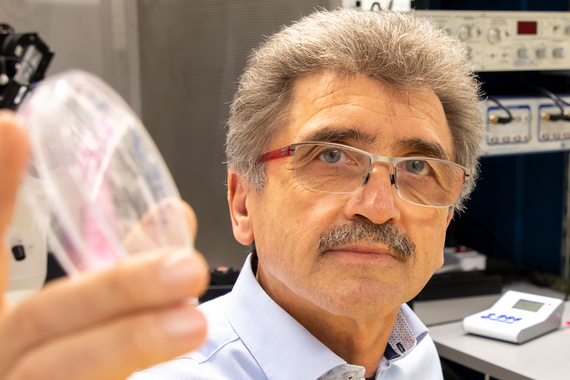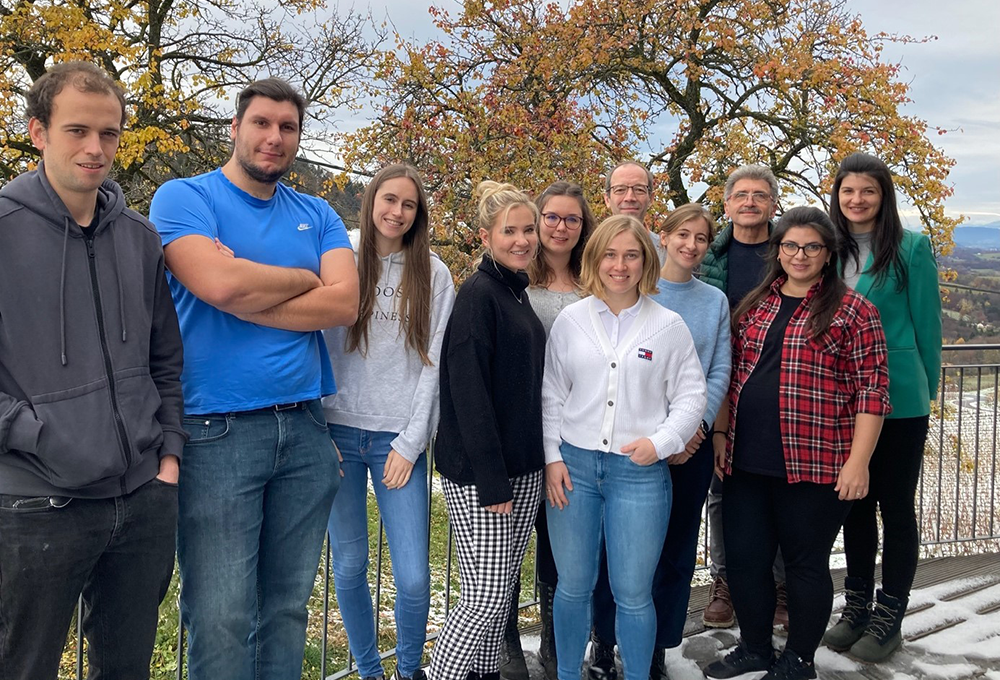- The University
- Studying
-
Research
- Profile
- Infrastructure
- Cooperations
- Services
-
Career
- Med Uni Graz as an Employer
- Educational Opportunities
- Work Environment
- Job openings
-
Diagnostics
- Patients
- Referring physicians
-
Health Topics
- Health Infrastructure
Research team Groschner
Research Focus: Signaling
PI: Klaus Groschner
Focus: Structure-function relations in ion channels with focus on regulatory lipidation and lipid-gating mechanisms. High precision control of ion channel function by photopharmacology and chemo-optogenetics. Calcium signaling within plasma membrane micro/nanojunctions.
Network: The Groschner Lab is part of the “Signaling Research“ field within the Gottfried Schatz Research Center and collaborates tightly with the groups of Wolfgang Graier and Roland Malli on ion channel signaling topics as well as with Tobias Madl, Pedro Sanches-Murcia and Gerd Leitinger on aspects of Structural Biology and Cellular Ultrastructure analysis. Key national/international project partners are listed in the project descriptions below.
Projects
Light-mediated control of TRPC3 function
- Lipid-regulated TRPC3/6/7 channels determine the fate of a variety of cell types throughout the human body. Altered TRPC channel function appears to be highly relevant as the basis of human pathologies such as cancer and inflammatory diseases. However, efficient therapeutic targeting of TRPC channels requires an in-depth understanding of the molecular principles of control of these ion channels by regulatory/therapeutic ligands. This project is based on recent findings on the molecular architecture of TRPC complexes and on technological progress in the field of spatio-temporal precise manipulation of ligand conformations by light (photopharmacology). The project will combine structure-guided mutagenesis and molecular dynamics (MD) simulation with photopharmacological and optogenetic technologies to arrive at new molecular concepts that enable highly precise manipulation of TRPC signaling in human tissues.
- Duration: 2020-10/2024
- Funded by: FWF P33263
- Project partners: Dirk Trauner, NYU, USA; Thomas Stockner, Medical University of Vienna und Toma Glasnov, Karl-Franzens University of Graz
Regulation of TRPV6 by PIP2 and the functional paralipidome
- TRPV6 plays a central role in various human diseases. Recently published studies and our own preliminary data show that mutations affecting Ca2+-mediated inhibition (CDI) and lipid (PIP2) regulation of TRPV6 are typically associated with altered channel activity and sensitivity to channel blockade by small molecules. Accordingly, we hypothesized that central mechanisms of TRPV6 regulation involve PIP2 in the functional paralipidome (FPL), through direct communication between TRPV6 and plasma membrane phospholipids, particularly PIP2. The aim of this project is to gain a detailed understanding of the molecular basis of TRPV6 regulation by FPL. The regulatory lipid coordination (PIP2 binding) in the TRP channel as well as local Ca2+-induced changes in the organization of PIP2 in the FPL will be analyzed. We expect a first assessment of the therapeutic relevance of the regulatory phospholipidome of TRPV6 channels.
- Duration: 2024-2027
- Funded by: FWF PAT 9543223
- Project partners: Alexander Sobolevsky, Columbia University, NY, USA; Thomas Stockner, Medical University of Vienna und Christoph Romanin, Johannes Kepler University Linz
Novel concepts for precise therapeutic targeting of TRPC and Piezo channels
Recent findings indicate a high pathological relevance of lipid-regulated (TRPC) and mechanosensitive (Piezo) ion channels. We therefore hypothesized that spatio-temporal precise control of channel functions and thus certain cellular signaling patterns may control cell fate and will allow for therapeutically valuable interventions. Since there is growing evidence that TRPC molecules as lipid sensors but also piezo channels as mechanosensors are involved in inflammatory processes of the skin and also in the progression of tumor diseases, we want to develop concepts that enable to influence the function of these molecules in keratinocytes but also in immune cells (mast cells, macrophages, NK cells) in order to achieve therapeutic effects. In addition, chemo-optogenetic methods, especially the genetic manipulation of cells in specific target tissues, will be established to enable highly effective, light-mediated intervention.
Funding application pending at FWF – PI Sanja Curcic




